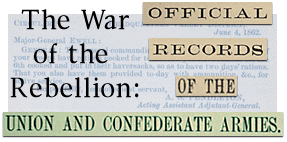Summary:
Brevet Brig. Gen. Thomas C. Devin commands the Second Brigade of the Army of the
Potomac which includes the 17th Pennsylvania Cavalry. Devin reports a brief, but
successful engagement.
Capt. A. E. DANA, Assistant Adjutant-Gen., First Cavalry Division.
September 1, 1864.
CAPT
I have the honor to submit the following report of the operations of this brigade from July 4, 1864, to September 1, 1864:
July 4, marched to and encamped at junction of telegraph and Light-House Point roads. July 16, marched to Jerusalem plank road, on the left of the army, and relieved the Second Cavalry Division and Bryan's Provisional Brigade, then picketing that flank. July 19, the pickets of the brigade were attacked and driven in by the enemy's infantry, who were immediately repulsed and the line re-established. July 20, were relieved by Chapman's brigade, of Third Cavalry Division, and returned to camp on telegraph road. July 26, marched to Appomattox River, crossed on pontoons, thence to James River, crossing by pontoons to Jones' Neck, from which point the brigade marched to Deep Bottom, arriving on the morning of July 27. The same day marched to New Market road, where the brigade encamped.
July 28 the brigade was ordered to support the Reserve Brigade, which has been heavily attacked, and the left of which forced back by Wilcox's division of rebel infantry. I immediately ordered the Sixth and Ninth New York and Seventeenth Pennsylvania Cavalry to prepare to fight on foot (the Fourth New York had been previously sent on a reconnaissance in the Charles City road.) While this order was in process of execution the enemy's line of battle appeared on the crest overlooking our position near the New Market road. To carry the enemy's position it was necessary to cross the men by file (on the run) through two passages across a swamp and ditch, and form on the bottom under the crest and the enemy's fire. This was quickly effected; I formed the squadrons as they passed through, and ordered the Ninth New York Cavalry to gain the woods on the enemy's right flank; the Seventeenth Pennsylvania Cavalry were ordered to support the Ninth New York, and as soon as the order was in process of execution I ordered the Sixth New York Cavalry to charge up the crest. The enemy, confused by the rapid and effective fire of the Ninth New York on their flank and the renewed attack of the Reserve Brigade on their left, retired precipitately when charged in front by the Sixth New York, and the brigade, closing in upon them, inflicted severe punishment, capturing seventy-two prisoners (besides a number of wounded), two battle-flags, and killing and wounding a large number of the enemy. The enemy showing a disposition to reform and advance, McIntire's section of Heaton's battery (which had already opened a heavy fire from the bottom) was ordered on the crest, and its splendid practice soon drove the enemy from the woods, where he was massing. The brigade was soon after relieved by Gibbon's division, of Second Corps. The Seventeenth Pennsylvania were ordered to take up a part of the new line for a time, but were retained until 10 p.m., and did not retire until they found the infantry had retired and left their flanks exposed. This short but brilliant engagement reflected great credit on the regiments engaged, and established the fact that our cavalry can dismount and with their carbines successfully repulse their own front of veteran infantry. Col. Cesnola, with the Fourth New York Cavalry, was for a time cut off from the command, but succeeded in coming in, with the loss of one man wounded and a few horses.
I am, captain, very respectfully, your obedient servant,
THOS. C. DEVIN, Brevet Brig.-Gen., Cmdg.
Bibliographic Information : Letter Reproduced from The War of The Rebellion: Official Records of the Union and Confederate Armies, Series I., Volume 43. Part I, Reports, Serial No. 144, Pages 470, Broadfoot Publishing Company, Wilmington, NC, 1997.

